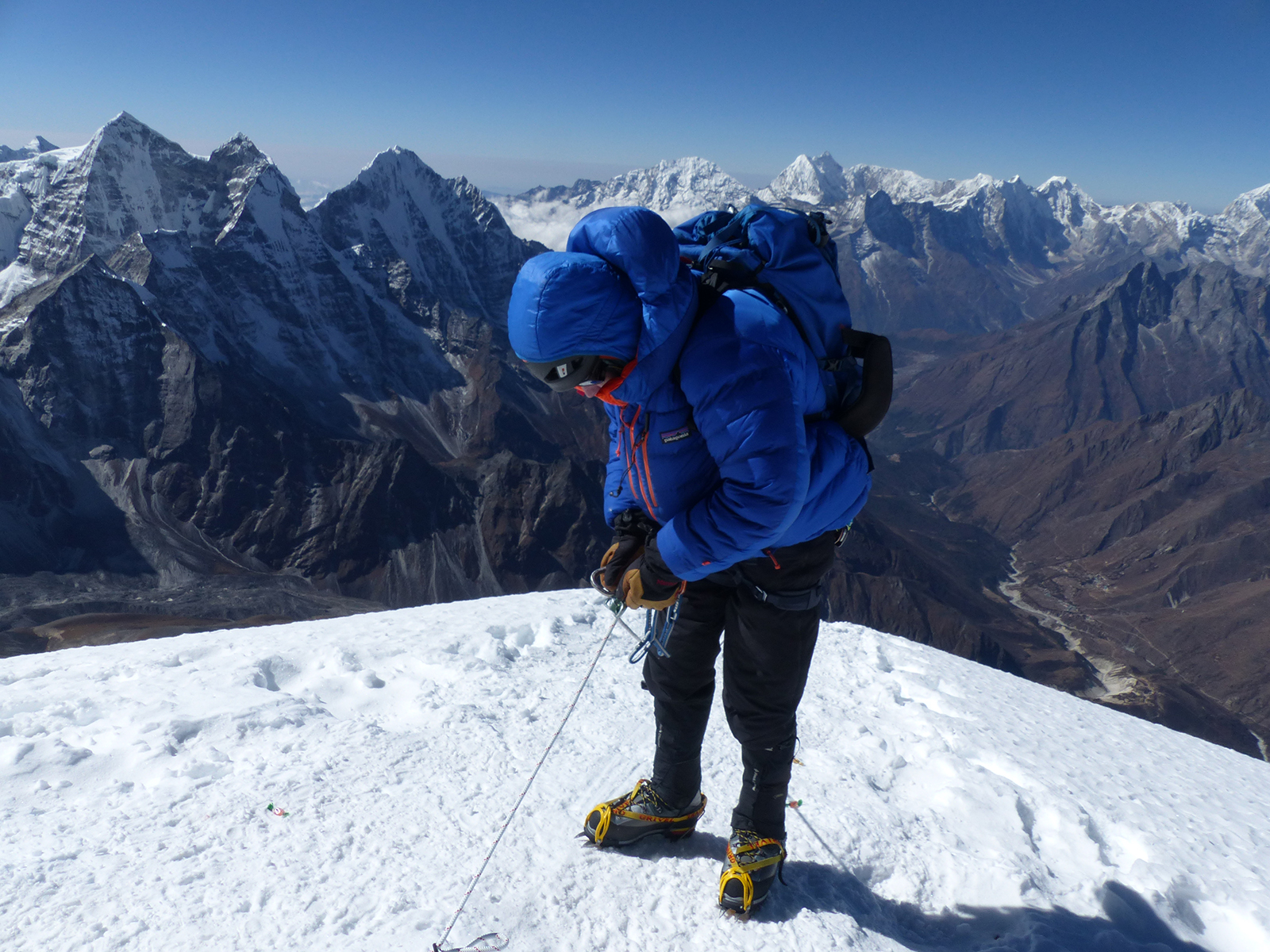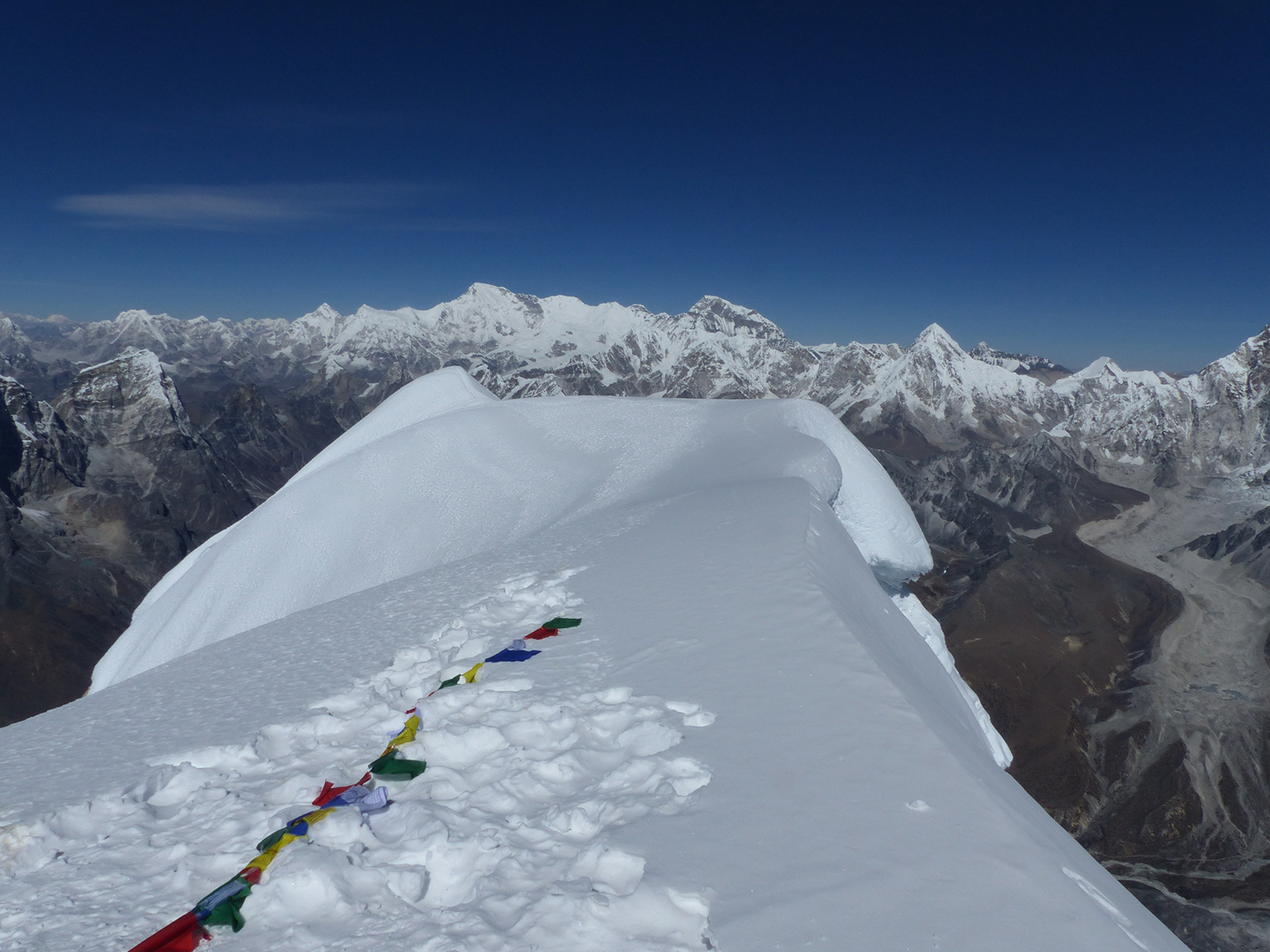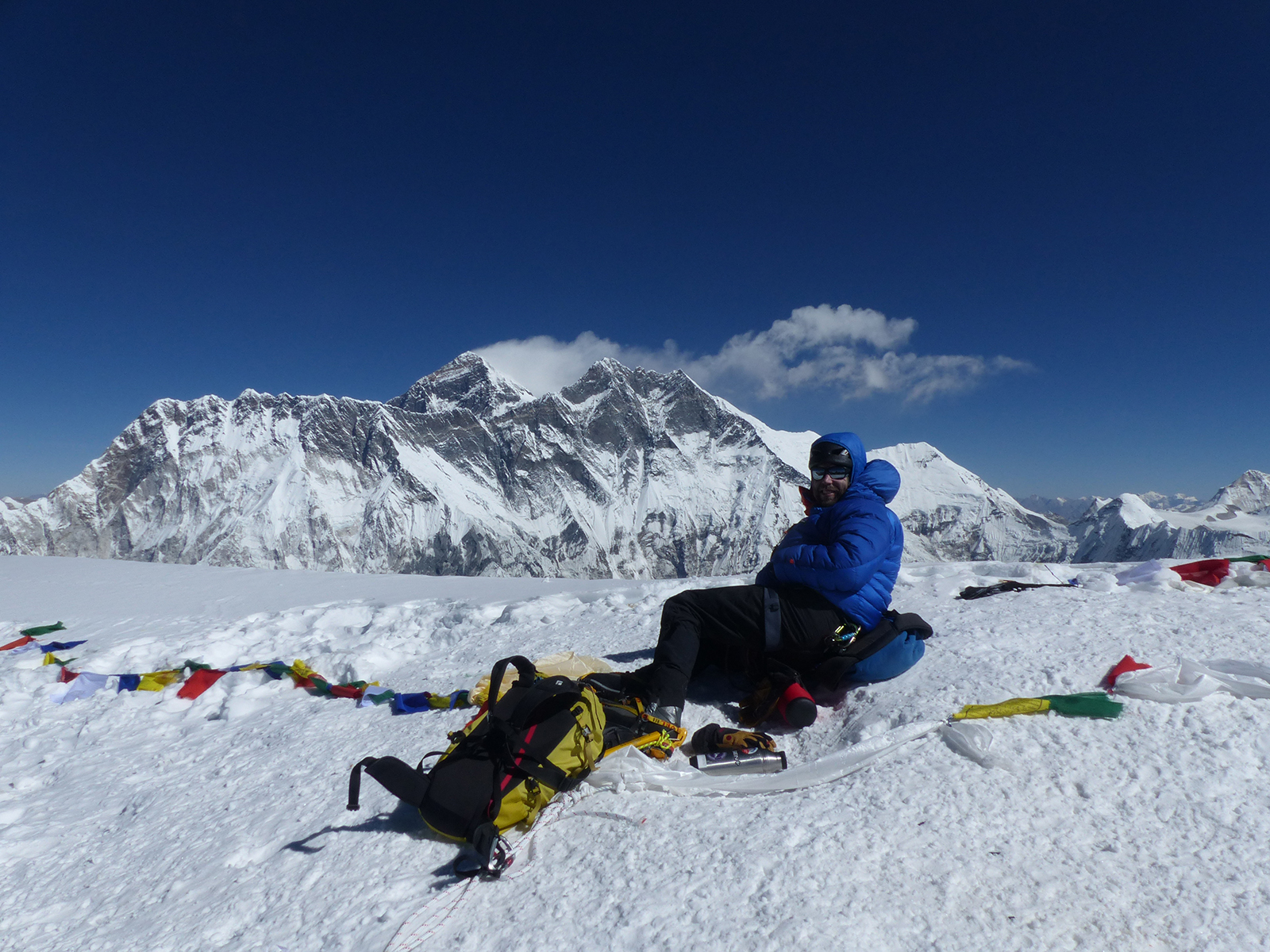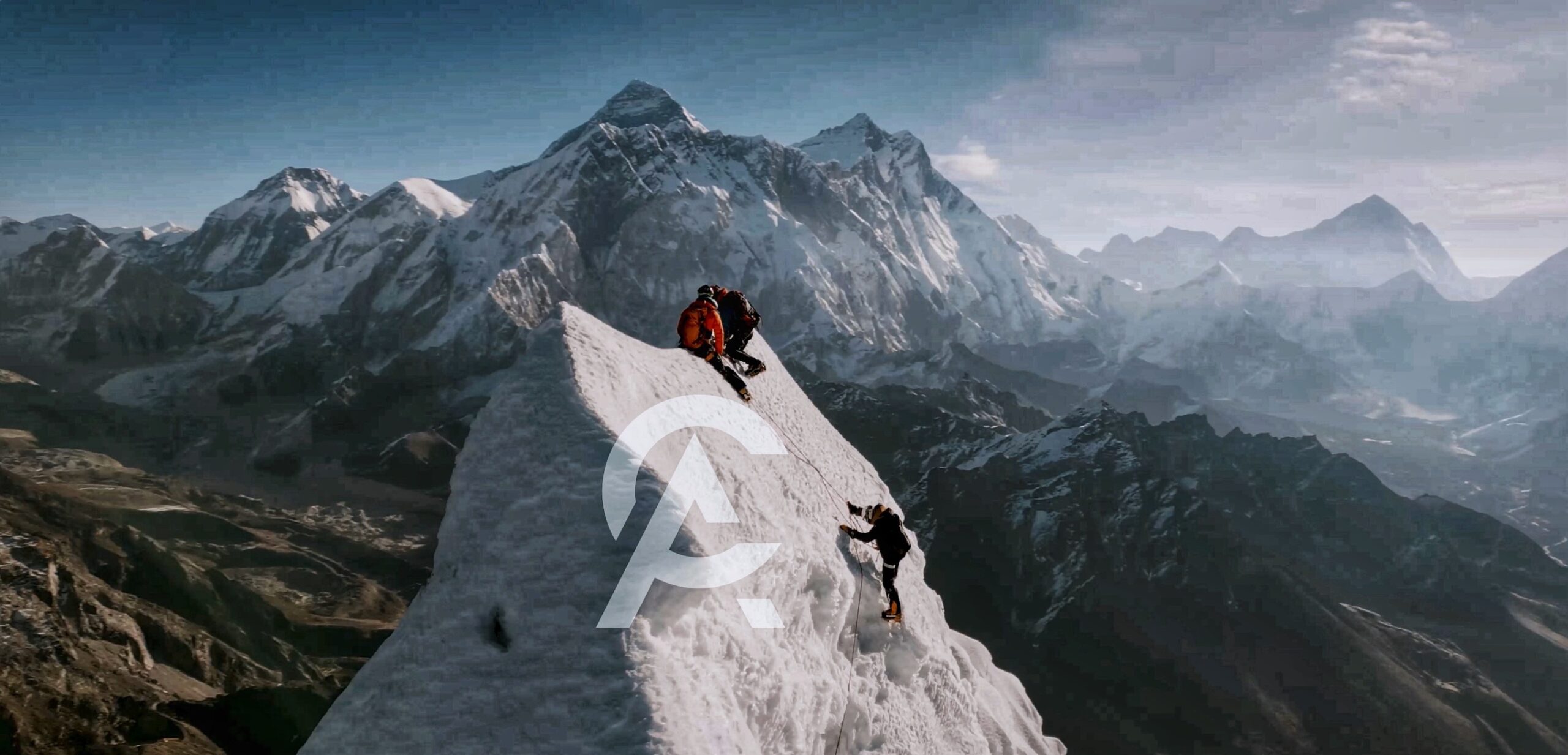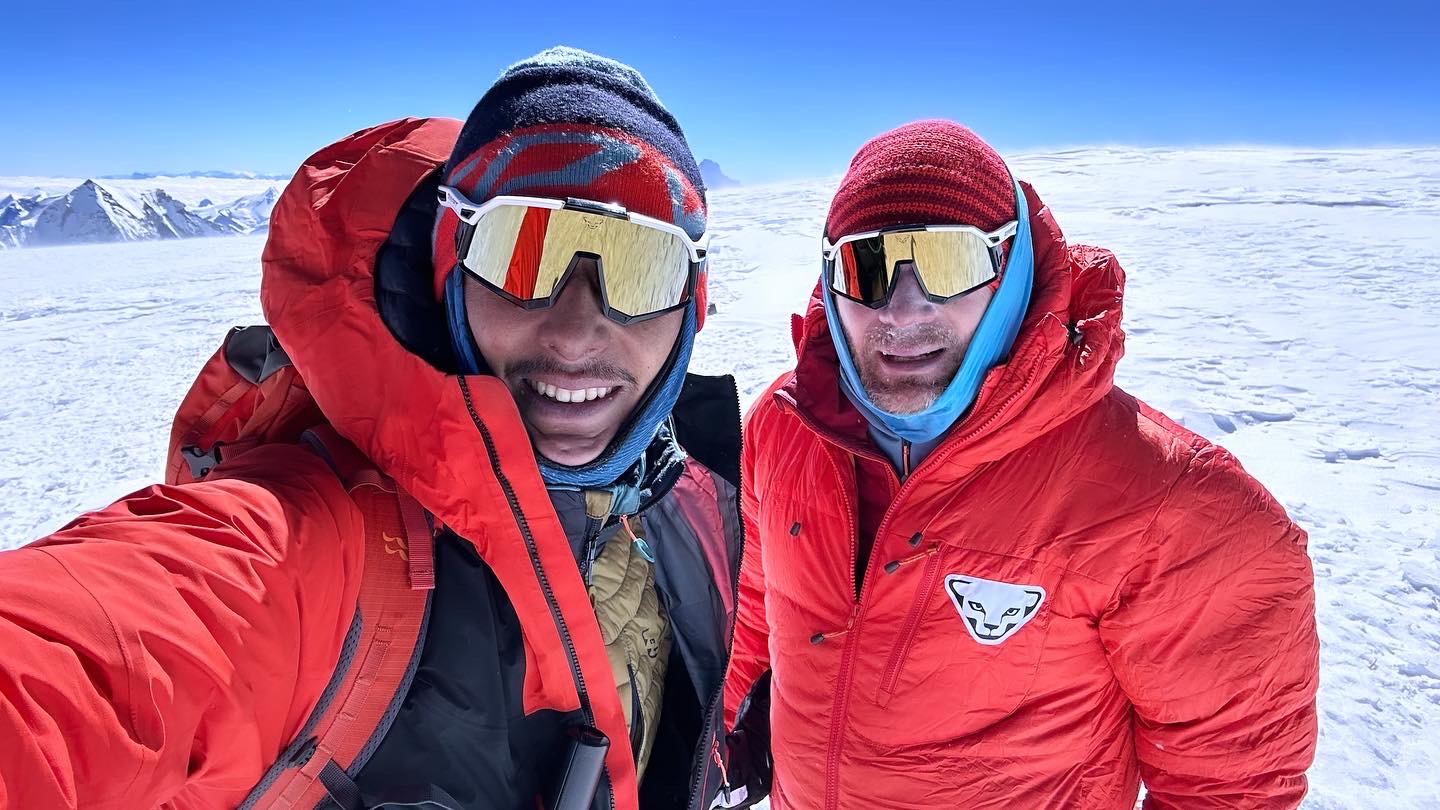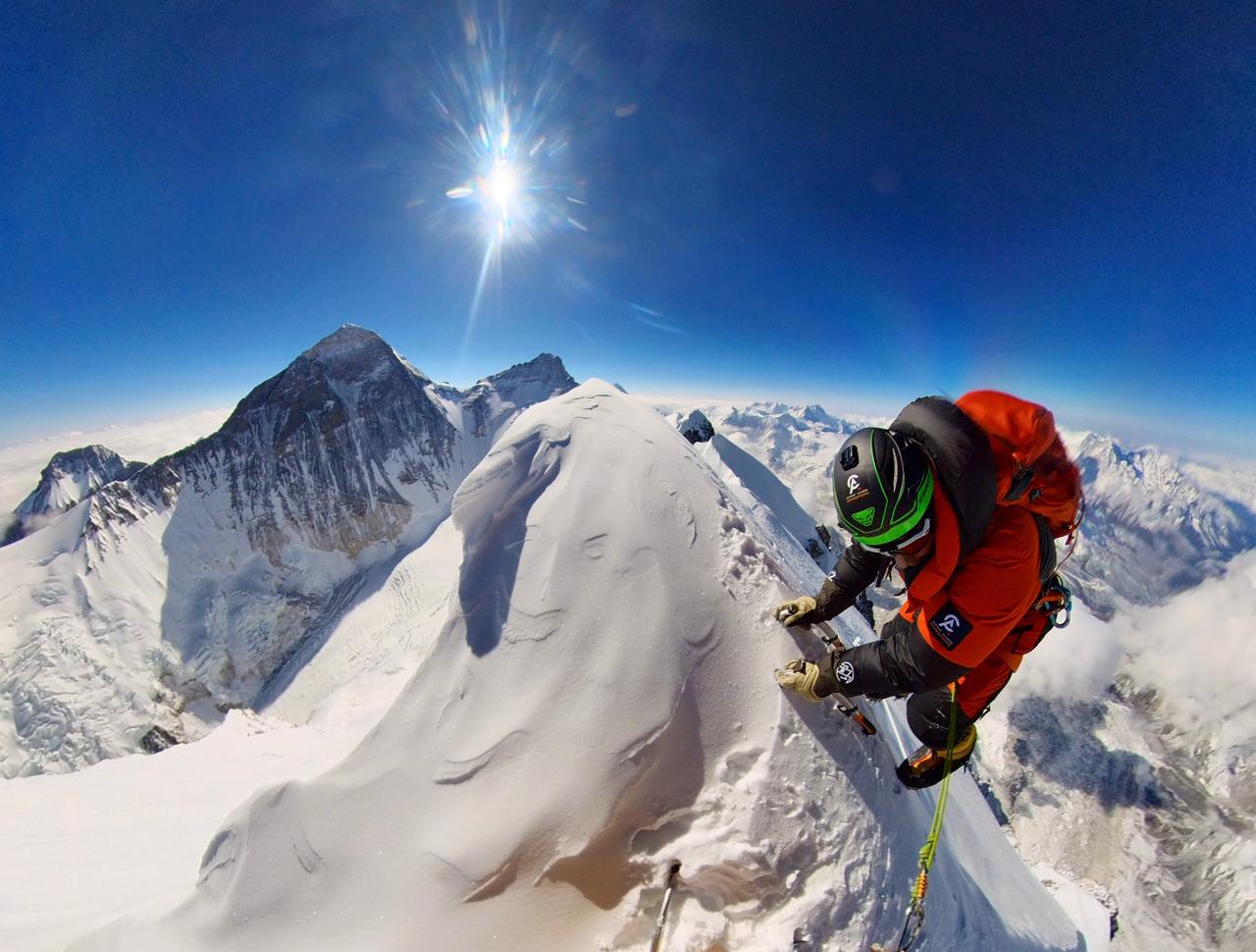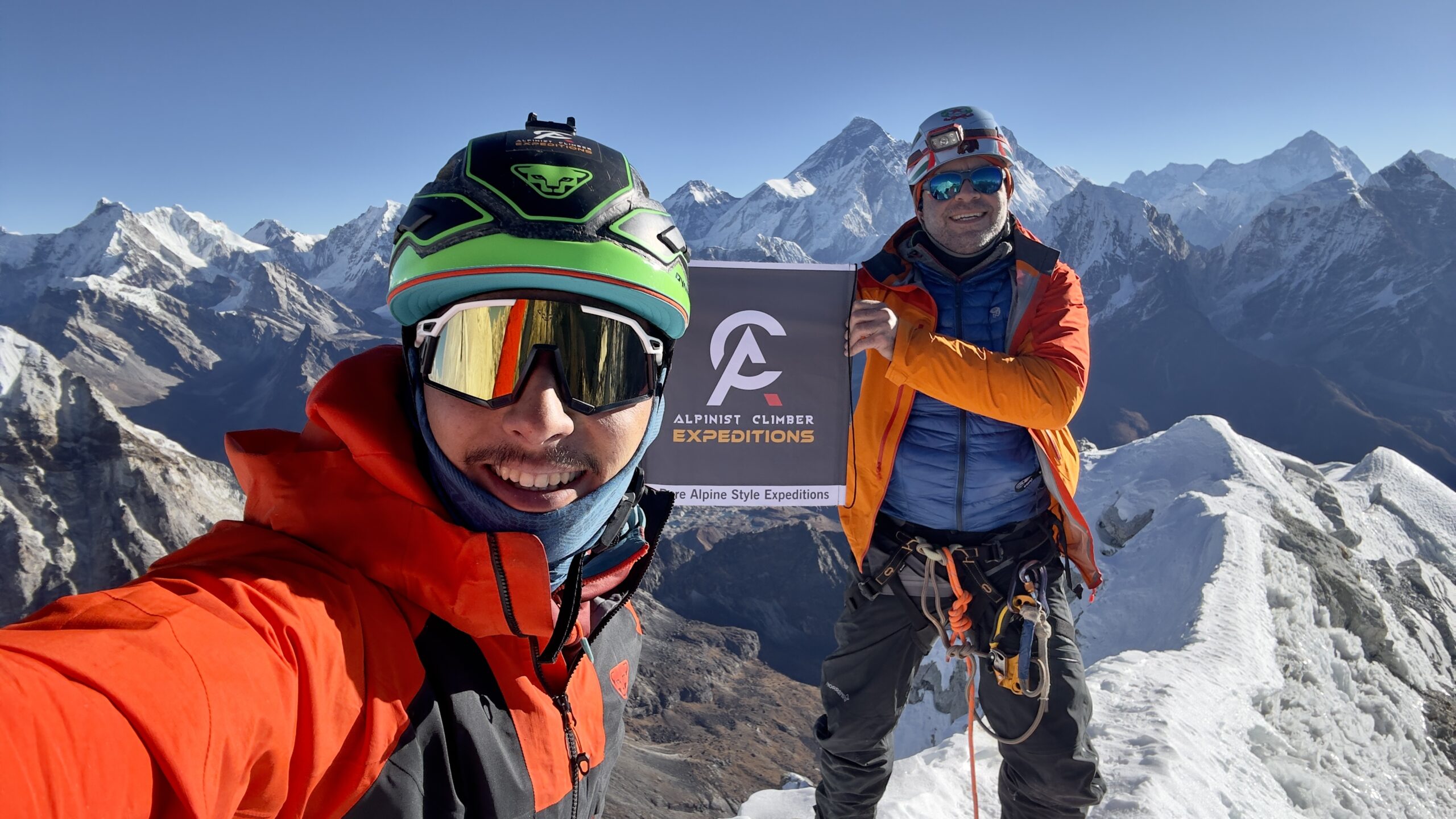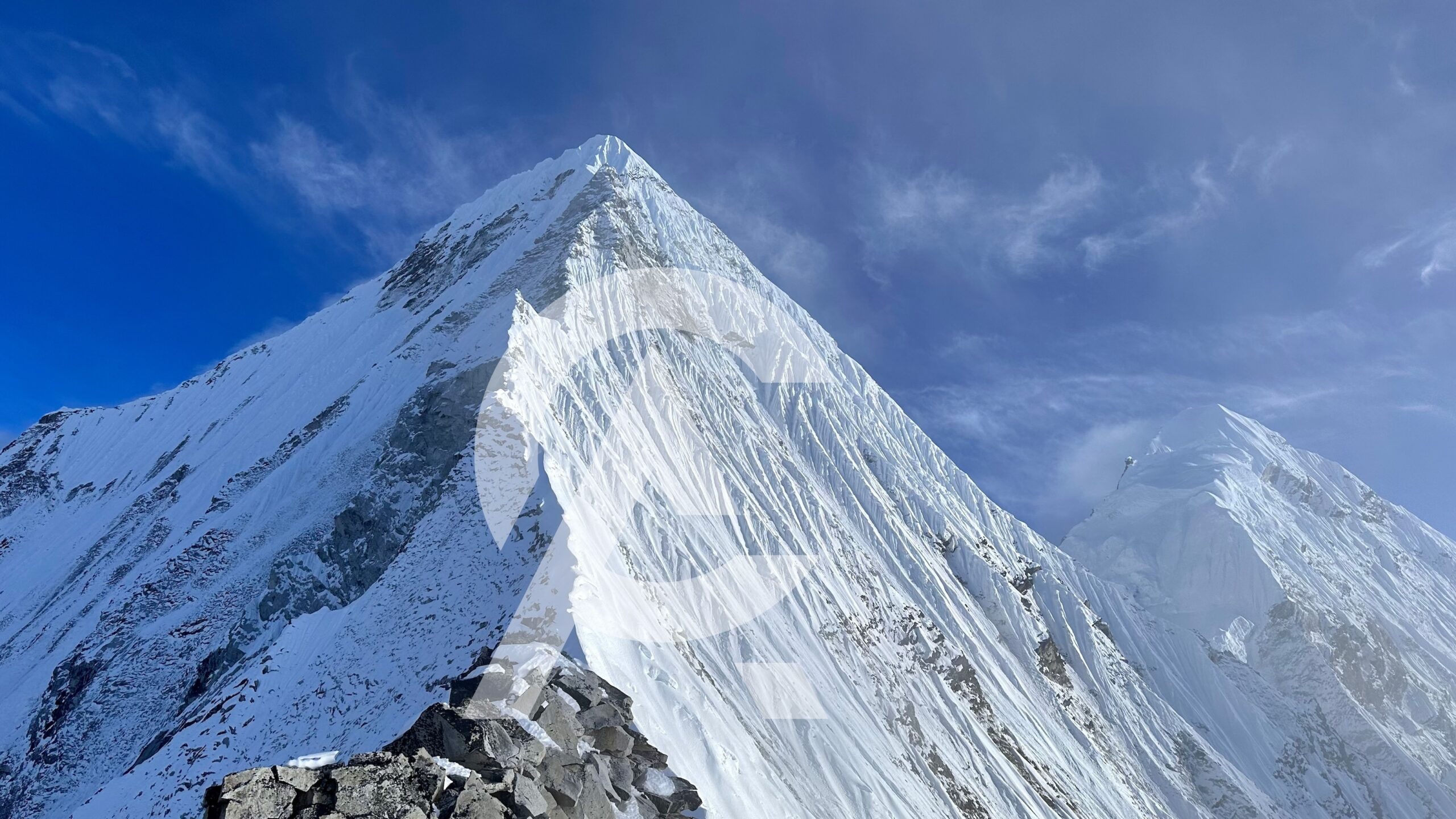Ama Dablam Expedition
Ama Dablam, located in the Khumbu region, is a mountain with a pyramid shape. Its name means “Mother’s Necklace” in the Sherpa language as its ridge looks like a mother’s arms protecting her child.
The climbing route involves steep ice, rock, and mixed climbing. Mountaineers should have previous experience in high-altitude climbing. Ama Dablam holds a cultural importance for the Sherpa people. They believe it is a sacred mountain and they prepare ceremonies to take blessings before start the climb.
Difficulty Level
Hard
Best Season
Autumn & Spring
Duration
24 days
Elevation
6,812m
Group Size
2 - 4
Trip Type
6000M Expedition
2025
6000M Expedition
- Starts from Kathmandu, Nepal
Overview
Ama Dablam, also known as “Mother’s Necklace,” is a one-of-a-kind mountain in Nepal’s Khumbu Valley. It was ascended for the first time in 1961. ‘Ama,’ at 6812m, is a difficult ascent due to the steep faces of snow, ice, and rock that must be navigated during the Southwest Ridge climbs. Climbers must have previous experience climbing with fixed ropes and be comfortable ascending along exposed ridgelines. The views from the peak is breathtaking, revealing Everest, Lhotse, Makalu, Cho Oyu, and Sishapangma.
Our expedition begins with a trek from Lukla along the Dudh Kosi river, passing through the Sherpa settlements of Monjo, Namche, Debuche, and Pangboche. We then depart the valley and climb to our base camp.
Our expeditions begin with a technical ascent with three camps above base camp. climbing usually takes less than four weeks. Climbing on this route involves pure rock climbing on elegant granite with mixed snow. The final section of the climb to the summit includes ice climbing up a steep snow slope. After finishing this difficult climb, you will reach the summit at an elevation of 6812m, with breathtaking views of Mt. Everest, Makalu, Cho oyu, Lhotse, Kanchanjunga, and many other peaks.
We have the most beautiful base camp on the mountain. We can bring large dining and personal room that you can stand up in with a mattress for sleeping because the base camp hotel is constructed on a large grassy plain. Because fresh food is available from the valley, our base camp meals are genuinely delicious! We have a modern communications technology system that provides us with regular weather forecasts, allows us to make phone calls and check-in via the internet, and coordinates with our mountain climbers and Sherpas. The views from base camp are spectacular, which is why we typically start the day with breakfast outside in the sunshine.
Our Sherpa team reserves our high camps ahead of time because space in these camps is usually limited. By reserving these camps and stocking them with food and cooking equipment, we are only required to carry our personal items during our acclimatization routines and rotations for the climb. Our Sherpa crew will already be in base camp several weeks ahead of us, planning the route. This is a significant benefit, and the route should be ready for climbing by the time we reach.
Itinerary
Day
Arriving in Kathmandu and transfer to the hotel
When you arrive at Kathmandu airport, a representative from Alpinist Climber Expeditions will be there to greet you and when you have gone through customs formalities, our representative will be on hand to transfer you to your hotel. Once you’re checked in, get ready for the expedition guide and other participants to go through the final preparation for the trip in the evening, get ready to enjoy Nepali cuisines!
Trip briefing and preparation
The guide goes through preparation and briefing with the team and formal procedures regarding the Ministry of Tourism you will be engaged in exploring the fascinating sights of the city. Our guided tour will lead you to some UNESCO World Heritage Sites in the Kathmandu valley. This final day is also for final necessary arrangements and a last-minute briefing on the expedition and grouping with the expedition team.
Fly to Lukla and trek to Phakding
After the flight out from Kathmandu, you will soon arrive at the mountain town of Lukla and the gateway to the Khumbu Region. This is an exciting flight, which should give a glimpse of Everest in the distance. Upon arrival, it is time to commence the first day of trekking as you make your way from Lukla to Phakding.
Trek to Namche
We will be trekking from Phakding Village to Namche Bazaar. We will continue up the banks of the Dudh Koshi, crossing it twice by small suspension bridges before reaching the village of Monjo where we will enter in the check-point of Sagarmatha National Park. We will then cross the confluence of the Dudh Koshi and the Bhote Koshi on a high suspension bridge and hike steeply for about three hours up ‘Namche Hill’ to reach Namche Bazaar.
Rest and acclimatisation day
Today we will rest our feet and prepare for the rest of the expedition. Namche Bazaar is the perfect place for an extra night and acclimatization, as we need to adjust to the low oxygen levels. So, we will hike up to Everest view point and explore the area around Khumjung. We will come back here to spend the night.
Trek to Tengboche
We begin our journey to the famous monastery of the Everest Region, Tengboche Monastery. The initial part of the trek is uphill and becomes gentler before it descends to a gentle mountain stream. It goes steep uphill towards Tengboche after crossing the stream. Tengboche is a small and beautiful village that has great views of mountain peaks. The monastery is popularly known as Tengboche Monastery and is a rich example of Buddhist cultural traditions found in the region. We unfold many monasteries before spending overnight here.
Trek to Pangboche
We wake up on a nice morning and enjoy breakfast overlooking the mountains. Today we go to Pangboche, so we embark on an adventurous walk of the day. Leaving the village of Tengboche, we follow a descending path between the high mountain, reaching Diboche. After crossing the suspension bridge over Imja Khola, we reach Pangboche on a steep ascent.
Trek to Ama Dablam base camp
Today we are going to Ama Dablam base camp. From Pangboche, we hike up the river, follow the trail and walk to the base of Ama Dablam. Shortly after walking across Pangboche, Ama Dablam seems to be nearby and makes for a beautiful sight. You can also get views of Everest (8,848m) Lhotse (8,516 m), Lhotse Shar (8,382 m), Nuptse (7,879 m), Lobuche Peak (6,119m), and other peaks that create the beautiful Himalayan panorama.
Puja Ceremony and Training day around base camp
Puja is an important ceremony in which we pay homage to the mountain and bless a safe passage before we go up the mountain. The puja includes a lama (monk) and our entire team, taking part in prayer, tossing rice and flour, and three sips of strong whiskey (just to name a few from the three-hour ceremony!).
The stupa is covered in beautiful decorations and sculptures made of butter and shampoo, with plates full of food and drink as offerings. It’s amazing to be there and be a part of it. As we approach the ceremony, it will also be a stop for final training before starting our destination.
We will train you at Base camp on how to move on a fixed-line rope, how to use all the necessary climbing equipment, and some climbing techniques that you will be using later. We will proceed to start the climb to Camp 1 and camp 2 in the next few days, now that we have the blessing of the Gods to move on. Tonight, we will continue to organize the equipment that will be sent to the mountains.
Hike to high camp and back to base camp
From here the expedition of Ama Dablam begins. We may not follow the day-to-day itinerary, as at the higher altitude, the climate is not predictable which may affect the expedition.
The expedition schedule of Ama Dablam is pre-determined by the expedition leader and the team members. The expedition leader knows the best possible way to approach the summit based on practical approaches judging the climbers and their own experience.
Therefore, we will hike for acclimatization, before returning to the Base Camp for the final preparation to scale the summit. Altogether there are three camps above the base camp before reaching the summit.
Hike to high camp
We will hike up to the high camp and we will see many mountain views early in the morning and evening. Sleep overnight here.
Hike to camp 1
It’s 2 hours away from high camp to camp 1 but the trail is mostly easy. You will detect a short section of casual rock and debris scattered about 100m in length.
To reach camp 1 you are required to climb some large boulder and climb an easy fourth-class slap and not be provided with any fixed rope in place.
Camp 1 is not as luxurious as base camp due to which you need to accommodate other climbers and share your tents.
Climbing up to camp 2 & back to camp 1
Camp two is situated at 6,100 meters and because of this the climb from camp 1 to camp 2 is the toughest during this expedition.
The climbing requires a fourth-grade horizontal rock ridge around various pinnacles and gendarmes, huge exposures with gigantic massive drop-offs on both sides of the ridge.
You will discover high-quality granite during your climbing sessions. When you are about to end your climbing sessions, you need to climb the yellow tower around 10 meters which are French 4th class, British Severe, North American YDS 5.5.
After climbing the yellow tower, you have arrived at Camp 2 for better acclimatization and to test our endurance and strength we will return back to camp 1 the following day.
Back to base camp
We will return back to base camp, rejuvenate and rest this day.
Summit push preparation
For the summit push, you must be prepared for 10-12 hours of uninterrupted physical exertion. The most efficient way to get ready for leaving for the summit push is to have a balanced meal, which we will eat just before we are set to go.
Hike to camp 1
We wake up at 6:30 am, after having breakfast, pack our backpacks, and move up to Camp 1, It’s 6 hours away from base camp to camp 1 but the trail is mostly easy. You will detect a short section of casual rock and debris scattered about 100m in length near camp 1, to reach camp 1 you are required to climb some large boulder and climb an easy fourth-class slap and not be provided with any fixed rope in place.
Camp 1 is not as luxurious as base camp due to which you need to accommodate other climbers and share your tents.
Climb up to camp 2
We wake up at 6:30 am, after having breakfast, pack our backpacks, and move up to Camp 2. It will take about 3-4 hours to reach camp 2. On this day we will have a light snack and enough liquid. Our guides will fix the camp 2, tents before we arrive, we will have hot soup and drinks after arriving at the high camp. Rest for the summit push.
Summit day
This is our summit day so after waking up at 2 am we prepare our necessary climbing equipment, food, and enough water and have proper breakfast, light snack and enough liquid as we begin to embark on the summit. We push forward to the summit and make our way back to camp 2. While summiting you will come across some pitches of dramatic but very solid snow-ice when climbing to the side of Dablam.
Upon finishing these pitches, you will arrive at a fluted snow/ice field (30-50º) exposing you to one of the world’s finest summits. From the summit, you can clearly distinguish Khumbu and with the panoramic beautiful views of Nuptse, Everest, Lhotse, Cho Oyu, Pumori, Kanchenjunga, Cholatse, Makalu, and many other mountains.
Contingency day
Unpredictable Weather conditions can make our journey more difficult. So just in case the weather forecast is not favorable we allot this day as a spare day. We might have to stay another night in camp 2.
Back to Base camp
After arriving at camp 2, we descend to base camp safely.
Trek to Namche Bazaar
After conquering the peak of one of the world’s most beautiful mountains, we will walk the same route to reach Namche Bazaar so it will be more like a revision of the scenery around but heavenly views of peaks like Everest, Nuptse, Lhotse, Ama Dablam etc.
Passing the Base Camp after breakfast, we take a downhill trail through some marvelous stones that are carved in the Imja Khola river and Pangboche.
After crossing the steel suspension bridge, climb uphill to Diboche and then a short steep climb through a thick jungle of birches, conifers, and rhododendron before reaching Tengboche. After few hours of hiking on the uphill and downhill trails, you’ll be back in Namche Bazaar.
Trek to Lukla
Finally, we trek all the way back to Lukla today to finish the Expedition Journey. We trek past Monjo and Phakding villages; meeting the Dudh Koshi River along the trail and finally reach Lukla.
As it’s the final day of the trek, we can celebrate the beautiful adventure and bid our trekking porters goodbye, thanking them for all the services they provided to make this journey worthwhile and possible.
Fly to Kathmandu
After waking up early for our flight back to Kathmandu. It’s time to say goodbye to the serene and magnificent mountains and board the flight to come back to modern hustle and bustle.
The afternoon in Kathmandu will be spent leisurely. Strolling the streets of Kathmandu; souvenir shopping; finding a massage or relaxing at the hotel can be the best ways to spend time.
Final departure
On this last day of our trip, we will drive you to the airport according to your flight schedule to see you off to your onward destination or back home.
It was a wonderful experience and a pleasure in meeting you, and we do hope just as the memories of our relationship will too be cherished.
We believe that you have enjoyed the Ama Dablam Expedition with us. We hope to see you for yet another adventure soon.
Inclusions & Exclusions
The price of your trip includes the following:
- Ama Dablam climbing royalty fees
- Certified IFMGA mountain guide with his daily wages and full insurance etc
- Garbage disposal & management fees
- Liaison officer with his wages, Insurance, transportation, etc
- Sagarmatha national park and Municipality entry fees
- Summit route fixing fees
- Hotel / Airport pick up and drop by private tourist vehicle
- 4-star hotel in Kathmandu with breakfast for 4 nights
- Flight from Kathmandu to Lukla both way
- Alpinist Climber Expeditions duffle bag, Cap, and T-shirt per member
- Accommodation & food in the local lodge are on full board during the trip
- Medical kit during the trip
- Porters to carry trekking and expeditions gear (1:1 ratios)
- Base camp lodge, single room with hot shower
- Camp 1, camp 2, tents for members and guides
- High-altitude snacks for members and guides
- EPI gas, cooking stoves and high food etc
- Experienced Sherpa support with his wages, full insurance
- Sherpa guide to assist the load carrying on the mountain & summit day
- All our government taxes, vat, tourist service charges
- Satellite Phone for emergency case
- All accommodation, wages, insurance, equipment, and medicine for all staff
- All official expenses
The price of your trip does not include:
- International flight tickets
- Nepal entry visa fees
- Meals in Kathmandu
- Alcoholic beverages
- Internet access (WiFi)
- Personal clothing and climbing equipment
- Personal first aid kit
- Personal travel insurance, medical and rescue insurance
- Drone Special permit fees
- Tips for Staff Guide, Sherpa, and Porters
Cost Details
Details
Our budget cost option presents an affordable alternative for individuals seeking a mountaineering experience without the higher price tag of the regular and premium options. This package retains the same level of service as the regular option, including group guiding with a minimum of 5 people per group, offering the chance to share the journey with fellow adventurers. The budget cost package encompasses professional guidance from our skilled team, a well-structured itinerary, and accommodations in budget hotels and lodges throughout the trip.
Details
Our regular cost option offers an excellent value for adventurers seeking an unforgettable mountaineering experience. With this package, you’ll have the opportunity to attempt stunning peaks, receive professional guidance from our experienced team, and enjoy a well-planned itinerary. Designed for groups, the regular cost option requires a minimum of 3 members to join the expedition, ensuring a shared experience and camaraderie throughout the journey. It’s an affordable and exciting way to embark on a memorable mountaineering adventure.
Details
- Private 1:1 guiding service for each member
- More flexibility
- Travel consciously
- Enjoy exclusive benefits
For those seeking a truly personalised and flexible adventure, our premium cost option is the perfect choice. With the premium package, you’ll receive exclusive benefits such as 1:1 private guiding, allowing for a more personalised experience tailored to your specific goals and preferences. This option provides the utmost flexibility in scheduling and ensures that you receive dedicated attention from our expert guides throughout the expedition. Indulge in the luxury of private guiding and elevate your mountaineering experience with our premium cost option.
Payment Details
Account Information
- Bank Name: Nepal Investment Bank Ltd
- Account Holder Name: Alpinist Climber Expeditions P. Ltd.
- Account No: 00101010343367
- Account Type: US Dollars
- Swift Code: NIBLNPKT
- Branch: Durbar Marg Kathmandu 44600
- Email. [email protected]
- Phone No: +977-9843314253
Why ACE ?
Alpinist Climber Expeditions is well-known for its expertise in organizing pure alpine-style expeditions, 1:1 private guiding with an IFMGA-certified mountain guide, and high-quality service throughout the expedition. With over a decade of experience in mountaineering expedition planning and coordination, we ensure that each expedition is a success with the best possible experience for our climbers while focusing on our three primary goals of reaching the summit, returning safely, and having fun! Our top concern is always safety.
Our IFMGA mountain guides are the most qualified and advanced in the industry. You will need a good understanding of technical climbing, expedition, and high-altitude experiences, as well as strong interpersonal skills. Our teams provide the best support system accessible, ensuring the best possible chance of success.
Trip Notes
Ama Dablam is not an expedition for ‘amateur’ climbers or those learning the ropes; there are simply too much at hazards. The Alpinist Climber Expeditions crew, as well as the operations and logistical teams, provide you enough backup and assistance to increase your possibilities of success.
This is also guaranteed by a very trustworthy expedition experienced guide team, which is combined with the Sherpa contingent, who you will discover are the best on the planet.
Prakash Sherpa (Pemba), CEO / IFMGA Mountain Guide.
Prakash Sherpa, the founder of Alpinist Climber Expeditions and a veteran of decades of high altitude expedition guiding and organizing the expedition. All of our trip guides have significant high-altitude experience and a track record of safety, success, and compatibility. The number of guides is determined by the size of the team, however the normal guide-to-member ratio is 1.1 Our guides are companionable and strong expedition members with significant power and a desire to see you succeed.
Support
A team of Assistant Sherpa Guides will help with load carrying on the mountain, and we will have a 1:1 Guide to climber ratio during the ascent.
Equipment
Body-wear
- Down suit
- Down jacket
- Waterproof jacket and over-trousers that goes over your alpine boot
- Balaclava – recommended BUFF or similar covering nose and face
- Long sleeve thermal shirt and trousers
- Fleece jacket and trousers
Hand-wear
- Liner gloves – thin and warm
- Down mitts
- Gore-Tex Primaloft glove.
- Mountain gloves – recommended water and windproof
- Smartwool mountaineering socks (2 pairs – new)
- Ultra-soft running / Hiking socks (2 pairs – new)
- Mountaineering boot – recommended La Sportive, etc.
- Alpine boot – recommended La Sportive and Scarpa, etc.
Climbing Equipment
- Climbing Helmet (UIAA tested)
- Harness – recommended Petzl or BD
- Goggles with UV protection and anti-fog system
- Sun glasses UV protection
- Headlamp – recommended Petzl or BD
- Spare batteries – recommended Energizer Ultimate Lithium batteries
- Ascender (Jumer) – recommended Petzl or BD
- Abseiling device – recommended Petzl or BD ATC guide
- Screw gate carabiners (2 x large, 2 small sizes) recommended Petzl or BD
- Bent gate carabiners (2 medium sizes) – recommended Petzl or BD
- 6 mm rope – recommended 2 meters UIAA tested
- 6 mm rope – recommended 5 meters UIAA tested
- Dynamic 8 mm rope – recommended 2 meters UIAA tested
- Classical alpine ice-ax – recommended Petzl, Grivel, or BD
- Crampons that fit mountaineering boots – recommended Grivel, Petzl, or BD
Other equipment
- Sleeping bag (comfort rated – 20 degrees
- Large size duffle bag with padlock
- Headlamp with spare batteries
- Water bottles 1 liter
- First aid kit
- Trekking poles
- 45–75-liter Rucksack
- Swiss army knife with a multi-tools system or Leatherman
- 1-liter stainless steel thermos – that works in extreme weather conditions
- Sleeping bag -20 and Thermarest mattress
Headwear
- Sun hat or Normal Cap
- Fleece or woolen hat
- Sunglasses with UV protection
- Buff scarf / thin face mask
Handwear
- Fleece or woolen thin gloves
- Gore-Tex mitten gloves
Bodywear
- Gore-Tex jacket
- Gore-Tex pant
- Hiking pant
- Fleece trousers and jacket or warm jumper – recommended not thick but warm enough that fits inside the Gore-Tex pant
- Anti-sweat T-shirt
- Thermal inner trouser
- Down jacket with hoodie
Footwear
- Trekking boots
- Slipper
- Trekking socks (4-5 pairs)
- Snow gaiter
Other equipment
- Sleeping bag (comfort rated – 20 degrees
- 45-liter rucksack with cover
- Large size duffle bag with padlock
- Headlamp with spare batteries
- Water bottles 1 liter
- Thermos
- First aid kit
- Trekking poles
Washing kit & Toiletries
- Waterproof washing kit bag
- Towel – medium size
- Washing soap, towel, tooth pest, toothbrush, etc.
- Sun lotion enough +50SPF (including total bloc for lips, nose, etc.)
- Handwash & sanitizer
- Toilet paper (you can buy it in the Lodges)
- Wet tissues
Terms & Conditions
Please read carefully our terms and conditions. Terms and Conditions are a very important part of the trip for members who are willing to book Expedition, Peak climbing, or trekking with Alpinist Climber Expeditions.
The terms and conditions contain the information to the client regarding the procedures of Booking Confirmation, Payment and Refund System and Cancellation policy, and other important information about your trip. The Booking Terms and Conditions constitute a legally required contract between Alpinist Climber Expeditions along with you for the services to be provided. The details of our Terms and Conditions are listed below.
- Alpinist Climber Expeditions accepts payment in Euros (€) and US dollars (US$). The currency will be
applied based on the location of the client. Once the initial deposit/payment has been paid, all
subsequent fees will be applied in the same currency.
- When Alpinist Climber Expeditions issues the written confirmation receipt of your deposit amount the
existence of the booking will be confirmed. Alpinist Climber Expeditions kindly requests you to make a
deposit of 20% cost of your trip. You are supposed to pay the remaining amount upon your arrival in
Kathmandu. You need to send your deposit to the Company. In the case of the customized trip, you
should do a 50% deposit as it will cover all intensive details. We accept a last-minute booking with 100%
payment in some cases.
- If you wish to make amendments to your tour arrangements we require notification to Alpinist Climber
Expeditions in writing. If any government permits, flight tickets, or insurance has been issued and cannot be
revoked and refunded you will be liable for these costs. You may also be liable for the cancellation fee of
airfares purchased on your behalf.
The future is unpredictable. Notice of cancellation shall be submitted by the client in writing providing
a reason(s) for cancellation. The refund procedure will be as follows:
- Cancellation before 60 days of the trip, 20% cancellation will be charged.
- Cancellation Before 30 days of the trip 40% cancellation will be charged.
- Cancellation Before 15 days of the trip 60% cancellation will be charged.
- Cancellation Before 07 days of the trip 70% cancellation will be charged.
If cancellation is made within the week of the departure or upon arrival in Kathmandu no
refund shall be provided. Any remaining payment will be required at this time. The cost of
Climbing Permit/Insurance/Equipment allowance is not refundable in any period of cancellation.
- Travel insurance is not included in the tour price, but it is a required condition of booking a trip with
Alpinist Climber Expeditions and your responsibility to ensure that you are adequately insured for the
full duration of the trip covering expenses against all possible risks including missed flights, canceled
trips, baggage loss, emergency medical evacuation, high altitude accidents, and other unforeseeable
events. All costs for emergency evacuation must be paid in cash in Nepal unless an insurance
company has agreed to pay the costs on your behalf. It is important to ensure that your personal
travel insurance covers all of the activities you participate in the Himalayas.
- The client / You are responsible to insure yourself with an insurance policy that covers
medical expenses, flight cancellation, trip cancellation, emergency evacuation, and any other
unforeseeable events that may cause loss to you.
- The client is responsible to bear all expenses of personal nature and any extra cost resulted
due to extended stay because of natural calamities, political strikes, and any uncontrollable
events.
- The client is responsible to book the flight tickets with a flexible time frame as traveling in the
The Himalayas can be unpredictable. In case of missed flights, the client shall be solely
responsible to bear the loss.
- If you wish to add extra services mentioned by the company in the Cost Inclusions
section of each package, you shall be entitled to bear the extra costs.
- The company is fully responsible to provide all the services mentioned in the Cost Inclusions
section.
- The company is responsible to introduce all the team members to guides, Climbing
Sherpas, Staff, and manager.
- The company is fully responsible to make the best arrangements for food, lodging, and
accommodation during the trip.
- The company is responsible to hear out the concerns of the member in terms of safety.
- The company is responsible to make prompt arrangements in case of emergencies during the
trek and expeditions.
- The company is responsible to provide valuable service to the clients and deserves pay to
the staff.
- It is your responsibility that you carry a valid passport and have rightly obtained the appropriate
visas when traveling with Alpinist Climber Expeditions. Please ensure that your passport is valid for 6 months from the Nepal Visa validity date.
- As part of the booking and permit process, we will need to obtain personal information from each
client. Your personal will be kept by us in a secure way and none of your private or personal
information will be disclosed for any other purpose.
- This agreement and the rights and obligations of the parties will be construed and take effect in
accordance with and be governed by the laws of Nepal.
Wishing you the best time in Nepal, Come as a friend goes as a family….. The land of Adventure and Hospitality.
FAQs
Ama Dablam is graded TD in the Alpine Grading System, which means long, serious, and highly technical. However, your entire climb from camp one to the summit will be assisted by a fixed rope, which makes the attempt easier. You must be in excellent physical and mental condition to tackle this challenging climb. On our guided climb, there will be a professional guide to assist you and provide you with instructions on skills relative to the climb.
You can attempt Ama Dablam during three climbing seasons: spring (April, May), autumn (October, November), and winter (December, January). During the spring season, there are fewer climbers than in the autumn, so climbers seeking fewer teams on the route are recommended to climb in the spring season. The autumn season is the main season for Ama Dablam, and many groups attempt the mountain during this period. The weather is stable, and there are more possibilities for summiting compared to the spring season. In the winter, you can expect cold temperatures and wind. There are fewer climbers and hikers on the trails, and if you want a challenging winter ascent, Ama Dablam is the right choice for you.
To prepare for Ama Dablam ascent, it is crucial to focus on endurance and strength training. This will help you handle the vertical sections of the ascent, like the Yellow Tower on the way to Camp 2. We suggest a variety of training activities, including long-distance running, cycling, gym training, rock climbing, and hiking with a heavy backpack. Ama Dablam’s climbing should be taken seriously. We require interested climbers to have a previous experience of 4000m to 6000m technical climbing experience anywhere in the world. Additionally, taking a mountaineering course can be useful in learning technical skills like rope climbing and the proper use of climbing equipment. You can check out our mountaineering courses, where our IFMGA mountain guides will equip you with all of the knowledge needed for the climb.
For the Ama Dablam climb, we use the Southwest Ridge route. The climb begins from Ama Dablam base camp at 4,600m and includes two higher camps, Camp 1 and Camp 2. The route involves steep vertical mixed climbing on rock, ice, and snow. The route from camp 1 to camp 2 is considered the most technical part of the expedition. Before camp 2, there is a 90-degree vertical ascent known as the Yellow Tower. Another challenge is the mushroom ridge. In this part of the route, you will need to carefully climb up and scramble on the steep rocky face of the mountain before reaching an exposed knife ridge. After this ridge, we reach Camp 3, which we skip and go immediately to the summit.
On Ama Dablam climbing trip, we provide two different options. The one is 1:3 guide to client ratio and the other one is 1:1 private guiding. In both options there will be one IFMGA lead guide and a Sherpa guide to assist you during the climb.
For the upcoming Ama Dablam trips in both spring and autumn seasons 2024-2025 our professional IFMGA mountain guides will be leading the expeditions. For private trips and for some of the group trips, our IFMGA guide Prakash Sherpa will lead Ama Dablam. Among with them, other experienced guides will assist you during the climb. We want to ensure that our clients will have a safe and successful trip with us.


